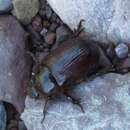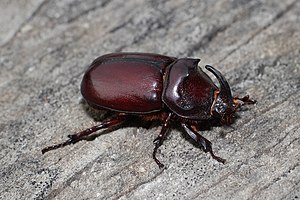pt-BR
nomes no trilho de navegação


Dynastinae or rhinoceros beetles are a subfamily of the scarab beetle family (Scarabaeidae). Other common names – some for particular groups of rhinoceros beetles – include Hercules beetles, unicorn beetles or horn beetles. Over 1500 species and 225 genera of rhinoceros beetles are known.[2]
Many rhinoceros beetles are well known for their unique shapes and large sizes. Some famous species are, for example, the Atlas beetle (Chalcosoma atlas), common rhinoceros beetle (Xylotrupes ulysses), elephant beetle (Megasoma elephas), European rhinoceros beetle (Oryctes nasicornis), Hercules beetle (Dynastes hercules), Japanese rhinoceros beetle or kabutomushi (Allomyrina dichotoma), ox beetle (Strategus aloeus) and the Eastern Hercules beetle (Dynastes tityus).

The Dynastinae are among the largest of beetles, reaching more than 15 cm (6 in) in length, but are completely harmless to humans because they cannot bite or sting. Some species have been anecdotally claimed to lift up to 850 times their own weight.[3] An extinct Eocene Oryctoantiquus borealis was the largest fossil scarabeid, with a length of 5 centimetres (2.0 in).[4] Some modern Oryctini grew up to 7 centimetres (2.8 in).[4] Common names of the Dynastinae refer to the characteristic horns borne only by the males of most species in the group. Each has a horn on the head and another horn pointing forward from the center of the thorax. The horns are used in fighting other males during mating season, and for digging. The size of the horn is a good indicator of nutrition and physical health.[5]
The body of an adult rhinoceros beetle is covered by a thick exoskeleton. A pair of thick wings lie atop another set of membranous wings underneath, allowing the rhinoceros beetle to fly, although not very efficiently, owing to its large size. Their best protection from predators is their size and stature. Additionally, since they are nocturnal, they avoid many of their predators during the day. When the sun is out, they hide under logs or in vegetation to camouflage themselves from the few predators big enough to want to eat them. If rhinoceros beetles are disturbed, some can release very loud, hissing squeaks. The hissing squeaks are created by rubbing their abdomens against the ends of their wing covers. Rhinoceros beetles are relatively resilient; a healthy adult male can live up to 2–3 years. The females rarely live long after they mate.
These beetles' larval stages can be several years long. The larvae feed on rotten wood and the adults feed on nectar, plant sap, and fruit. First, the larvae hatch from eggs and later develop into pupae before they reach adult status (see picture at left). The females lay 50 eggs on average. Contrary to what their size may imply, adult rhinoceros beetles do not eat large amounts, unlike their larvae, which eat a significant amount of rotting wood.
Male Japanese rhinoceros beetles (Allomyrina dichotoma) fight to dominate sap sites. Males use their horns to pry rival males off the area, which also may give them the chance to mate with a female. In this and other species that defend mating sites, larger males with larger horns mate more frequently, as they win more contests. Small males often avoid larger males and exhibit alternative strategies to gain access to females.[6][7]
Rhinoceros beetles have become popular pets in parts of Asia,[8] due to being relatively clean, easy to maintain, and safe to handle. Also in Asia, male beetles are used for gambling fights.[9] Since males naturally have the tendency to fight each other for the attention of females, they are the ones used for battle. To get the two male beetles to lock in combat, a female beetle is used, or a small noisemaker duplicating the female's mating call.
Entomologist Séverin Tchibozo suggests the larvae contain much more protein (40%) than chicken (20%) and beef (approximately 18%), and they could become a protein source for a large human population.[10]
Dr. MinJun Kim, leading a team of engineers in National Science Foundation-funded research, examined the function and aerodynamics of Allomyrina dichotoma with the help of researchers in Drexel University's Mechanical Engineering Department and in collaboration with Konkuk University in South Korea. Rhinoceros beetles could play a big part in the next generation of aircraft design.[11]
Some species can become major pests, e.g., in tree plantations. Usually though, beetle population densities are not as high as in some other pest insects, and they typically prefer food trees which are already sick or dying from some other cause. Some species' larvae, however, will attack healthy trees or even root vegetables, and when they occur in large numbers, can cause economically significant damage. The fungus Metarhizium majus is a proven biocontrol agent for beetle infestation in crops.
Auth: Burmeister, 1847. all genera:
Auth: Laporte, 1840. Selected genera:
Auth: MacLeay, 1819. Selected genera:
Auth. Lacordaire, 1856; genera:
Auth: Mulsant, 1842. Selected genera:
Auth. Endrödi, 1966; all genera:
Auth: Mulsant, 1842. Selected genera:
Auth: Burmeister, 1847; selected genera:
 European rhinoceros beetle
European rhinoceros beetle Dynastinae or rhinoceros beetles are a subfamily of the scarab beetle family (Scarabaeidae). Other common names – some for particular groups of rhinoceros beetles – include Hercules beetles, unicorn beetles or horn beetles. Over 1500 species and 225 genera of rhinoceros beetles are known.
Many rhinoceros beetles are well known for their unique shapes and large sizes. Some famous species are, for example, the Atlas beetle (Chalcosoma atlas), common rhinoceros beetle (Xylotrupes ulysses), elephant beetle (Megasoma elephas), European rhinoceros beetle (Oryctes nasicornis), Hercules beetle (Dynastes hercules), Japanese rhinoceros beetle or kabutomushi (Allomyrina dichotoma), ox beetle (Strategus aloeus) and the Eastern Hercules beetle (Dynastes tityus).
Hornbiller (Dynastinae) er en gruppe av biller som hører til familien skarabider (Scarabaeidae). Denne underfamilien omfatter noen av de aller største og tyngste billene. I Norge forekommer det bare én art i denne gruppen, neshornbillen (Oryctes nasicornis).
Middelsstore til meget store (10-175 millimeter) biller, kroppen mer eller mindre sylindrisk. På farge er de vanligvis svarte, men kan være kledt med lyse skjell, og dekkvingene er ofte rødlige eller gulaktige. Det er ofte stor forskjell på kjønnene. Hannen er vanligvis markert større enn hunnen, og har et langt horn på hodet, ofte også ett til tre fremoverrettede horn på pronotum. Disse hornene viser vanligvis såkalt allometrisk vekst, det vil si at de blir forholdsvis større jo større dyret er. Hos Dynastinae er det gjerne betydelig størrelsesvariasjon innen en art. Antennene er korte og vifteformede. Beina er temmelig lange, særlig forbeina kan være forlenget, ytterst med kraftige klør, leggen (tibia) har vanligvis kraftige tenner på yttersiden. Larvene er fete og tynnhudete, vanligvis hvite, med C-formet kropp (scarabaeiforme larver).
Dynastinae forekommer hyppigst i skog, men kan leve i mange ulike miljøer. Bortsett fra gruppen Cyclocephalini besøker de sjelden blomster. De fleste har larver som lever i død ved eller muld, der de eter råtnende vegetabilsk materiale og utviklingen tar gjerne flere år. Undergruppen Phileurini skiller seg fra de øvrige ved at både larver og voksne er rovdyr, med den mer næringsrike dietten kan larveutviklingen gå vesentlig raskere. Tross sine tunge kropper flyr disse billene godt. De eter gjerne råtnende frukt. Hannene bruker hornene sine til å sloss om hunnene, en hann prøver gjerne å få hornet under motstanderen og vippe ham over på ryggen. En del arter er regnet som skadedyr, enten fordi de voksne billene gnager på planter eller fordi larvene kan ete røtter.
Gruppen forekommer i alle verdensdeler bortsett fra Antarktis, men de fleste artene er tropiske. Den er forholdsvis artsfattig i de nordlige områdene, med 13 arter funnet i Europa men bare én (neshornbillen) i Nord-Europa.
I nyere inndelinger blir gruppen ofte regnet som en familie for seg selv, Dynastidae.
Hornbiller (Dynastinae) er en gruppe av biller som hører til familien skarabider (Scarabaeidae). Denne underfamilien omfatter noen av de aller største og tyngste billene. I Norge forekommer det bare én art i denne gruppen, neshornbillen (Oryctes nasicornis).